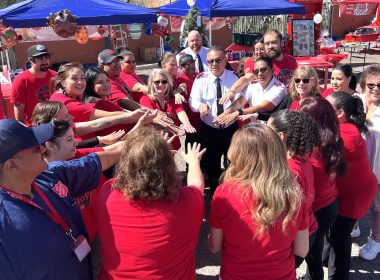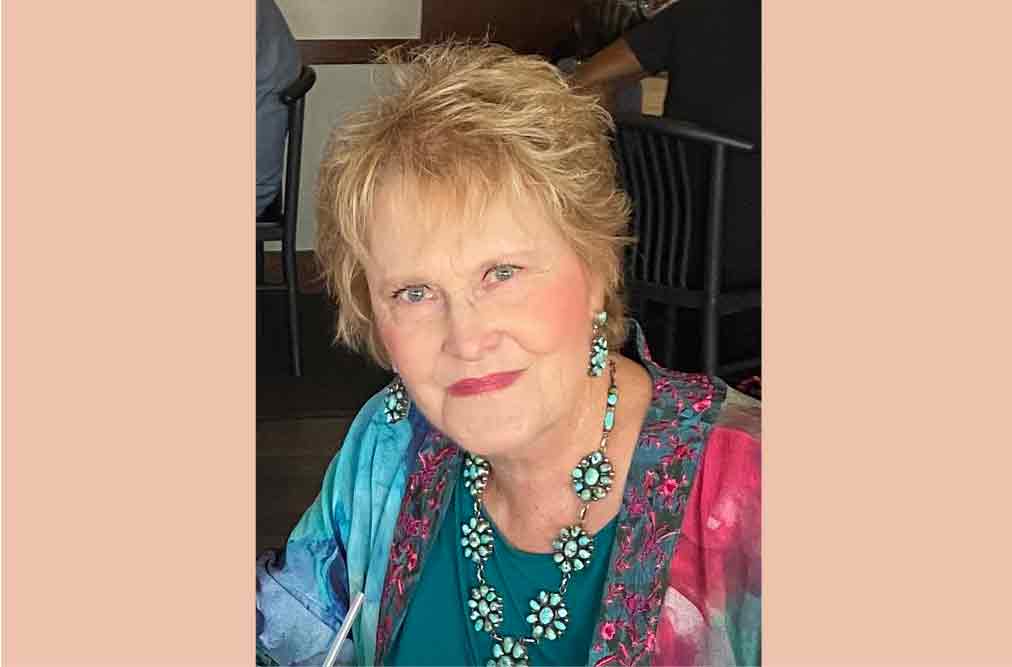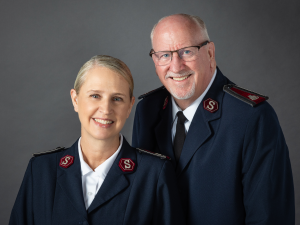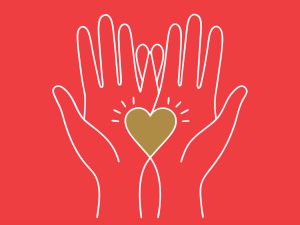If you’ve ever donated gently-used items to The Salvation Army or shopped in one of our thrift stores, then you’ve directly supported addiction rehabilitation in your community.
Across the U.S., The Salvation Army has more than 130 residential treatment facilities which equip more than 150,000 people a year to combat addiction, build work and social skills and restore families. Each of these facilities sift and sort the public’s donations that are then sold in more than 1,200 thrift stores nationwide.
And those sales fund the cost-free, biblically based six-month program helping so many people find not only sobriety, but recovery.
Cheryl Tuck-Smith is the mom of one of those program graduates. She’s experienced the transformation that results, and for the past 20 years, has stayed involved in the effort in Chico, California.
Now in retirement after a career as an attorney, Cheryl has taken on a new role overseeing what she calls, Grandma’s Jewelry Box.
As an advisory council member for The Salvation Army Chico Adult Rehabilitation Program, Cheryl offered to help sift and sort donations of jewelry, looking for items to be sold in the area’s seven thrift stores.
When she discovered the warehouse had more jewelry than she could get to, she recruited help. The group of volunteers now meets weekly and have turned it into a ministry.
Cheryl is on the show today to share more about the effort, what they look for and the result—a remarkable average monthly income from the majority $4 to $10 pieces of jewelry for sale.
Show highlights include:
- What it was like to be raised on the great American Plains.
- What being a lawyer taught Cheryl about life.
- How she met The Salvation Army.
- More about her involvement with the Adult Rehabilitation Program in Chico.
- How “Grandma’s Jewelry Box” came to be.
- What the volunteer effort entails—and the results they’ve seen.
- An additional benefit of being at the Adult Rehabilitation Program each week.
Listen and subscribe to the Do Gooders Podcast now. Below is a transcript of the episode, edited for readability. For more information on the people and ideas in the episode, see the links at the bottom of this post.
* * *
Christin Thieme: Cheryl, welcome to the Do Gooders Podcast. Thank you for joining me today.
Cheryl Tuck-Smith: Well, thank you for having me.
Christin Thieme: Yes, this is exciting. I’m excited to hear more about what you’re up to these days. But before we get there, let’s hear a little bit more about your story and what led up to today. I know that you grew up on a cattle ranch near Cheyenne, Wyoming. What was it like to be raised out on the Great American Plains?
Cheryl Tuck-Smith: It was fantastic. We had incredible freedom. We learned about nature and life and hard work and responsibility. In retrospect, I think I was really blessed to be raised that way.
Christin Thieme: Definitely. It sounds beautiful. I love it. Then I know you went on to teach elementary school and then later became an attorney and you practiced civil law for 25 years. What did being a lawyer teach you about life?
Cheryl Tuck-Smith: Well, let me think about that for a second. What I learned, I believe, is lots of people have difficulties in life. Some people handle them more smoothly than others. Some people keep getting into the same type of mess over and over and over. So I would say I learned that I could help some people, and there were people I really could not help.
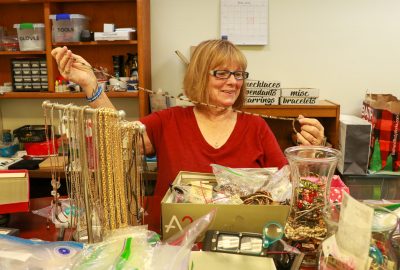
Christin Thieme: Interesting, yeah. How did you come to meet The Salvation Army?
Cheryl Tuck-Smith: Well, that was through my daughter, who had difficult teenage years through drug addiction, and once she had gone through The Salvation Army rehabilitation program in San Francisco was when we got connected with The Salvation Army because we would go visit her on the weekends, and take her little girl to visit her. We saw what The Salvation Army was doing. That’s when I think it was on my heart to help in some fashion because I learned I could not help my daughter, but maybe I could do something that would help other people that were ready to change their lives, and because of that, after my daughter finished the rehabilitation program, she came back to Chico, and we started ringing bells for The Salvation Army at Christmastime. Then we just got more and more involved with The Salvation Army.
Then at one point, the Chico Salvation Army corps decided it wanted to raise money to start an adult rehab program in Chico, so I got involved in that as a vice-chairman, and helped raise the $5 million we needed to start the adult rehab program in Chico. My heart has been there ever since because I see what happens and how many people’s lives The Salvation Army is changing. One of the things that was important to me is that the Chico adult rehab serve women and men. That’s very unusual in The Salvation Army. We in Chico were not sure it would work, but we’re still serving women and men at the Chico adult rehab program, and it’s wonderful.
Christin Thieme: That’s incredible. I know that was nearly 20 years ago that you helped to raise all that money to start this program. You’ve spent many years serving since as a member and even the president of the Advisory Council on the board there. Can you give us a little bit of some insight and a picture into what is the adult rehabilitation program there? What goes on? What’s day-to-day life as part of that program like?
Cheryl Tuck-Smith: Well, the thing I like the most about it’s not one of those rehab programs where you sit around and wring your hands all day and blame your mother and father for all your troubles. It is a residential work therapy program. What that means is to be accepted into our program free of charge, by the way, we do not charge the beneficiaries, and for them to enter the program, they have to come in clean and sober, and they have to be willing to work because we have a warehouse full of donations, and those donations are sorted through. Not only do they work in the warehouse, but some of the people have jobs in the laundry because bedding has to be washed, clothing has to be washed. Some of the beneficiaries work in the kitchen because they’re fed three meals a day. Some of the beneficiaries work at cleaning because obviously this is a large facility with a men’s dormitory and a woman’s dormitory as well as a full kitchen and a chapel and offices, so there’s lots of cleaning that needs to be done, so there’s also a cleaning crew.
The beneficiaries work five days a week, they’re required to go to, I believe it’s five NA or AA meetings per week. We provide chapel on Wednesdays that they’re allowed to go to if they so choose. They also do counseling. Each beneficiary receives counseling and they do work groups that are suited to their needs, such as trauma recovery, sobriety, anger, management, all those types of things. The person has to go through this program for six months and then they graduate and graduation is a huge event because it’s monumental for so many of these people that have been on the street into drugs for many, many years. One of the things I love to do as an Advisory Council member, our council gives a graduation gift to each beneficiary. The men receive watches and I make Swarovski crystal bracelets for each of the ladies. Those are gifts we want to send them with to let them know how proud we are of what they’ve achieved.
Christin Thieme: I’m sure that means a lot, too, and it’s something tangible to look down at each day, and remember. I love that. You mentioned the donations. Beneficiaries attend these programs without any fee, like you said, but donations help to support the effort. Can you talk a little bit about what exactly that means, what that looks like?
Cheryl Tuck-Smith: Well, the donations, I think all of us have done are clothing, shoes, furniture, those types of things, and so those items are sorted through and priced and sent to The Salvation Army thrift stores. Our warehouse serves seven thrift stores and one of those we call Elite Repeat, which is the higher-end product that we receive as a donation, and that’s where my efforts have come in now because I’ve been working on sorting jewelry.
Christin Thieme: I love it. This is what we really wanted to get into today. I understand that last year you were brought in and asked for help—that there was just an enormous amount of donated jewelry that nobody really knew what to do with. So can you tell us a little bit about what’s come of that since then?
Cheryl Tuck-Smith: Well, what happened is I didn’t really know quite what I was getting into when I said, “I think I can tackle jewelry pricing and helping get the jewelry to the stores.” Well, when I realized we had at least 50 or more totes, and when I say “totes,” I’m talking about a plastic box, that’s about three feet by 18 inches deep and probably 18 to 20 inches wide full of jewelry donations, and they’d been sitting in the warehouse because we did not have enough beneficiaries to sort through the jewelry.
Secondly, it wasn’t cost-effective to hire people to sort through the jewelry, price it and get it to the stores, so I started what is called Grandma’s Jewelry Box. That’s much what it’s like for we ladies that are all volunteers. We meet once a week and we sort jewelry, price jewelry and clean it. Then we send it out to the warehouse and it’s divided up between our seven stores. What we do keep and take down ourselves is the higher-end jewelry. Sometimes it could be gold, sterling, platinum, and we take that down to Elite Repeat, and help put it in the glass cases. It’s a rather big process and we have a great time doing it.
Christin Thieme: It sounds fun. Tell us, when you open one of these totes that’s stuffed full of all this donated jewelry, what do you do? What do you look for as you’re sifting through it all?
Cheryl Tuck-Smith: Well, we look for things that could be a little more valuable than just costume jewelry. For instance, every now and then we’ll find real pearls, we’ll find American Native jewelry that’s been signed, we find gold chains, and so we’re looking for things. Oftentimes, they’ll have a mark on them. What’s funny is we can’t see those marks. We can see the mark, but we can’t read it, so that’s why I bought a microscope that really expands the size of the mark, so we can read and see if it’s 14-carat gold ring, for instance, and then we’ve learned to test that 14-carat gold ring to see if it truly is, and then we’ve learned to weigh that gold ring to see what the value of the gold is in the ring, so that we can price it. We’ve learned all of those things that none of us knew before we started this.
Christin Thieme: Right. I imagine you didn’t have much experience with that as an attorney.
Cheryl Tuck-Smith: Very little experience. My experience was I liked jewelry, and I particularly like Native American jewelry, so I had a little knowledge of jewelry. One of our volunteers, Susie, had worked for a department store for about a year in their jewelry department, so she recognized some of the higher-end costume jewelry like Monet or Trifari.
The other thing we’ve been really excited about is we find some collectible jewelry. For instance, in the 1940s and ’50s, lots of women’s suits were sold with those beautiful broaches that glittered and glimmered, and those are very collectible. At one point, I was able to find a lady that is a collector of that type of costume jewelry, so she has joined us weekly, and she is invaluable in helping us spot these treasures. Some of these things you would never think were valuable are very valuable.
Christin Thieme: Interesting.
Cheryl Tuck-Smith: We’ve also learned to do the research. If something has a mark that we’ve never seen before, we research it to find out what the value of that item is. One of my most fun examples is this, we found a ring that looked like silver, but it was marked PD. I had no idea what that was, so I researched it and found out it’s called palladium. Well, palladium is worth more per ounce than gold.
Christin Thieme: Interesting.
Cheryl Tuck-Smith: We valued that, send it down to Elite Repeat, and it also had some little diamond chips in it. Well, for months, nobody bought it. Everybody thought it was silver. When I realized that I came home and put on my computer what that item was made of and made a little sign and put the daily value of palladium and it sold within a week after I put the sign up.
Christin Thieme: Interesting. Yes, that was creative.
Cheryl Tuck-Smith: Well, those are the kinds of things we’ve learned just by doing this.

Christin Thieme: How are these items sold? You said you price them and then they’re divvied up between these stores. What’s the display, or how are they presented in the stores?
Cheryl Tuck-Smith: Well, we’ve gotten a little better at that. I call it we’ve evolved. We’ve started putting earrings on cards, much like what you and I would buy costume jewelry on at Target, and so we put the earrings on the cards, and we put the price on there. Then those items are taken to the stores and put in glass display cases like you’d see at Macy’s. We’re getting better at displaying those items so people, as they shop, can actually see them. Instead of just looking at a bunch of necklaces on a stand, we’re now displaying them on that stand attractively, and in the cases attractively, so we’re again evolving there on helping the thrift stores do their designing in the cases.
Christin Thieme: What’s been the result?
Cheryl Tuck-Smith: Well, that is what’s really been exciting to find out. When we started this in April a year ago, 2021, we thought if we could pull in $2,000 a month in jewelry sales, that would be wonderful. Your audience I hope knows that our jewelry is sold at like the price of $4, $10, $12. It’s not high-priced, so we thought $2,000 per month would be wonderful. Well, in the past six months, we’ve been averaging over $5,000 a month in just jewelry sales in all of our stores.
Christin Thieme: That’s amazing.
Cheryl Tuck-Smith: We’re shocked.
Well, the other thing that feels so good about that, Christin, is that if we pull in $60,000 a year in jewelry sales, that amounts to serving over 33 of our beneficiaries at the adult rehab program per month.
Christin Thieme: Wow.
Cheryl Tuck-Smith: Well, not 33 per month, but 33 per year we are serving because the cost of providing the rehabilitation program for each beneficiary is $1,800 a month, so we feel really good that we’re able to help these beneficiaries, and keep the adult rehab program going.
Christin Thieme: Yeah. I mean, that’s a direct impact. It’s incredible. You meet with this group of ladies one day a week, is that right, for a few hours? Then do you have much interaction with the beneficiaries and the people around the adult rehabilitation program?
Cheryl Tuck-Smith: Oh, we do. That’s been exciting. The reason it’s exciting for us is we get to have lunch with the beneficiaries, so we work for about three hours in the morning. Then we have lunch with the beneficiaries and I and some of the ladies have started having lunch with the female beneficiaries and it’s been so rewarding because we talk to these ladies, we sometimes even witness to them, and we really try to encourage them to keep doing what they’re doing, because sometimes it’s very, very hard for them. Many of the women and the men do not have their children anymore, their children are in foster care, or with a family member, and so we just keep encouraging them to do that one step at a time each day so that they can get their children back, if that’s their goal. It’s so rewarding to watch these ladies and the men grow in their sobriety.
Christin Thieme: Yeah, absolutely. What’s been the best part for you of doing this now? I mean, it’s been six months. Is there a story that particularly stands out to you, or something that’s just really meant a lot to you along the way?
Cheryl Tuck-Smith: I think what’s meant so much to me is to be able to achieve the income for the Army so that the Army can continue to do its services. I would say the other thing that has been very heartwarming for myself and I believe the other volunteers is we’ve really developed a fellowship with each other.
Christin Thieme: Right.
Cheryl Tuck-Smith: That has been just very rewarding.
Christin Thieme: Yeah, and like you said, getting to really know the people who are benefiting from the sales of this jewelry and getting to know them as people, I think that’s incredible. I love it.
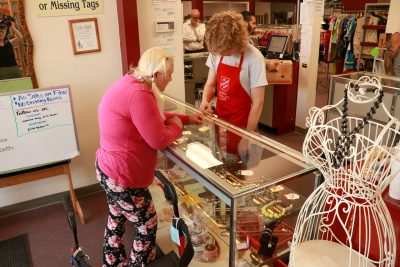
Cheryl Tuck-Smith: One of the things, Christin, that my daughter has explained to me is that so many of these beneficiaries have had a really rough life, and a lot of it of their own choosing, but because of that, they have not had much interaction with just regular people, like myself and the other volunteers, so the fact that we talk to them like regular people is something that they seem to appreciate, and so when we see them at the adult rehab center where they’re saying hello to us and they smile and we see them in the warehouse and they try to help us, they open doors for us, they carry things for us, so you see this back-and-forth interaction in a normal life.
I think the beneficiaries enjoy that as much as we do. In fact, this is kind of fun, this week, the man that is in charge of the kitchen is one of our graduates, and he asked me what our ladies’ favorite lunch was, and so we told him, and he says, “Oh, good. I’m going to fix you your favorite lunch next week.”
Christin Thieme: Sweet. So simple, but so meaningful.
Cheryl Tuck-Smith: Exactly. That’s the type of thing we encounter with our interactions.
Christin Thieme: How would you suggest somebody who’s listening go about getting involved in some way, maybe it’s not taking over the entire jewelry display system for the adult rehabilitation program, but just being around this program, and knowing the experience that you have, what would be your encouragement for someone in some tangible way that they could get involved today?
Cheryl Tuck-Smith: I would encourage them to start just attending a Salvation Army corps, church, and finding out what services that corps offers in the community. Then simply saying, “I’d love to come in and help serve meals,” or, “I’d like to come in and just volunteer in the stores,” or whatever it is that corps needs, just come in and say, “Hey, I’ll answer phones for the morning,” or whatever it is. There’s so much talent that particularly retirees have that is not tapped.
One thing that people can use at the adult rehab programs is somebody helping them fill out a job application, or how to open a bank account and manage your bank account, how to fill out a rental application. All of those simple things that many people take for granted, so many of the people receiving our services don’t have any of those skills, so just offering a class and filling out a rental application would be very helpful.
Christin Thieme: Yeah. I love it. Get involved in the way that you can with the skills that you have.
Cheryl Tuck-Smith: Exactly.
Christin Thieme: There’s room for everyone. Absolutely. Well, Cheryl, thank you so much for sharing. Thank you for the work that you’re doing. You are, without a doubt, having an impact in so many ways with The Salvation Army and the people that we serve, so thank you on behalf of The Salvation Army for everything that you are doing.
Cheryl Tuck-Smith: Well, and thank you for The Salvation Army for what it provides for so many people. Most of the public is not aware of the scope of The Salvation Army services, and it just feels so good to be part of it, so I’m glad I can be part of it.
To learn more about Grandma’s Jewelry Box, watch the video below:
Additional resources:
- You’ve probably seen the red kettles and thrift stores, and while we’re rightfully well known for both…The Salvation Army is so much more than red kettles and thrift stores. So who are we? What do we do? Where? Right this way for Salvation Army 101.
- See how The Salvation Army fights addiction.
- Have you ever found yourself wanting to volunteer but unsure of what to do or how to go about it? Here’s the key: You can make an impact in the Fight for Good with whatever time and skills you have. Whatever your interest, there is a you-sized need for goodness in the world. Get the guide on How To Be An Impactful Volunteer with 9 habits to make a difference when giving back.
Listen and subscribe to the Do Gooders Podcast now.

